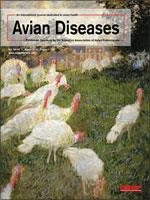Factors responsible for the persistence of Arkansas Delmarva Poultry Industry (ArkDPI)-derived infectious bronchitis vaccines in commercial flocks and the high frequency of isolation of ArkDPI-type infectious bronchitis viruses in respiratory cases are still unclear. We compared dynamics of vaccine viral subpopulations, viral loads, persistence in trachea and cloaca, and the magnitude of infectious bronchitis virus (IBV)-specific antibody induction after vaccination with two commercial ArkDPI-derived Arkansas (Ark) serotype vaccines. One of the vaccines (coded vaccine B) produced significantly higher vaccine virus heterogeneity in vaccinated chickens than the other vaccine (coded A). Chickens vaccinated with vaccine B had significantly higher viral loads in tears at 5 days postvaccination (DPV) than those vaccinated with vaccine A. Vaccine B also induced a significantly higher lachrymal immunoglobulin M response at 11 DPV, an earlier peak of IBV-specific lachrymal immunoglobulin A, and higher serum antibodies than vaccine A. In addition, a significantly higher proportion of birds vaccinated with vaccine B had vaccine virus detected in the trachea at 20 DPV than those vaccinated with vaccine A. Furthermore, the virus detected at 20 DPV in most of the chickens vaccinated with vaccine B was a single specific subpopulation (subpopulation 4) selected from multiple vaccine subpopulations detected earlier at 5 and 7 DPV in the same chickens. On the other hand, a higher proportion of chickens vaccinated with vaccine A had virus detected in cloacal swabs at 20 DPV. Thus we found differences in mucosal antibody induction and selection and persistence of vaccine viruses between two ArkDPI-derived vaccines from different manufacturers. The higher vaccine virus heterogeneity observed in chickens vaccinated with vaccine B compared with those vaccinated with vaccine A may be responsible for these differences. Thus the high frequency of Ark IBV viruses in the field may be due to the inherent ability of some ArkDPI-derived vaccine viruses to be selected and persist in vaccinated chickens. Vaccine virus persistence may offer genetic material for recombination or may undergo mutations with the potential to result in increased virulence.
Comparación de la selección de subpoblaciones vacunales, carga viral, persistencia el virus vacunal en la tráquea y cloaca y respuestas de anticuerpos en las mucosas después de la vacunación con dos vacunas diferentes derivadas del serotipo Arkansas-Industria Avícola de Delmarva.
Los factores responsables para la persistencia de las vacunas contra la bronquitis infecciosa que son derivadas del serotipo Arkansas Delmarva Poultry Industry (ArkDPI) en las aves comerciales y la alta frecuencia de aislamiento del serotipo ArkDPI en casos respiratorios aún no se ha clarificado. Se comparó la dinámica de las subpoblaciones virales vacunales, las cargas virales, la persistencia en la tráquea y la cloaca, y la magnitud de la inducción de anticuerpos específicos contra el virus de la bronquitis infecciosa (IBV) después de la vacunación con dos vacunas comerciales derivadas del serotipo Arkansas ArkDPI Arkansas (ARK). Una de las vacunas (codificada como vacuna B) produjo significativamente una mayor heterogeneidad viral en los pollos vacunados en comparación con la otra vacuna (codificada como vacuna A). Los pollos vacunados con la vacuna B mostraron cargas virales significativamente más altas en las lágrimas a los 5 días después de la vacunación (DPV) que los pollos vacunados con la vacuna A. La vacuna B también indujo una respuesta significativamente mayor de inmunoglobulina M en las lágrimas a los 11 días después de la vacunación, y mostró un pico más temprano de inmunoglobulinas específicas contra el virus de bronquitis infecciosa en las lágrimas, además de anticuerpos séricos más altos que la vacuna A. También, una proporción significativamente mayor de las





